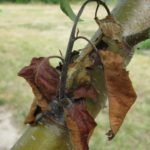Fire blight seems to have established itself in many orchards throughout the state, meaning it can still be a huge threat in the event of trauma, like hail, due to secondary spread. Secondary spread develops when stormy weather, especially hailstorms, occurs after the primary (blossom) infections. The amount of fire blight that develops after severe[Read More…]
Pome Fruits
The summer meeting of the Indiana Horticultural Society will be held June 22 at Doud’s Countyline Orchard in Wabash, IN. We will also visit a couple of other farms close to David Doud’s. The final details are still coming together, but I encourage you to mark this date on your calendar and plan to attend.[Read More…]
The pollination season was challenging this year and it appears that chemical thinning won’t be simple either. I think in most cases, pollination turned out to be adequate to set full crops. If growers are in doubt they should cut a few fruit in half and look for normal seed development. Before we talk about[Read More…]
Although the season for primary scab infection is winding down, this cool, wet weather is making for an excellent infection period for juniper rusts (Gymnosporangium spp). John Obermeyer and I created this time-lapse video to help explain the complicated lifecycle of this fascinating pathogen: http://tinyurl.com/j3s3t92 The juniper rusts standout due to the conspicuous nature of[Read More…]
I achieved biofix today (May 9) in our orchard at the Meigs Farm near Lafayette. I have also talked to other growers who had also caught 3-5 moths or more in their pheromone traps. For me, I had caught one moth last week and caught three more over the weekend. This constitutes a sustained flight and[Read More…]
Fire blight, caused by the bacterium Erwinia amylovora, is a devastating disease of apples and pears. Epidemics of the disease develop quickly, particularly in a climate of warm, wet weather, with hail events—like last night’s 0.75” to 1.5” hail! The type of management program developed by each orchard will vary considerably based upon a variety[Read More…]
We’re getting close to the time when growers need to make chemical thinning decisions – for many the most perplexing and risky decision they will make all year. This is usually a tricky call to make, even more so when we have had spring frosts. Luckily in most places the spring frosts have not been[Read More…]
Apple growers should have their codling moth pheromone traps in place now. See the April 12 edition of Facts for Fancy Fruit for details of where traps and pheromone lures can be purchased. Traps should be checked for moths several times per week, if not daily. Pheromone lures should be replace about every 3 weeks.[Read More…]



